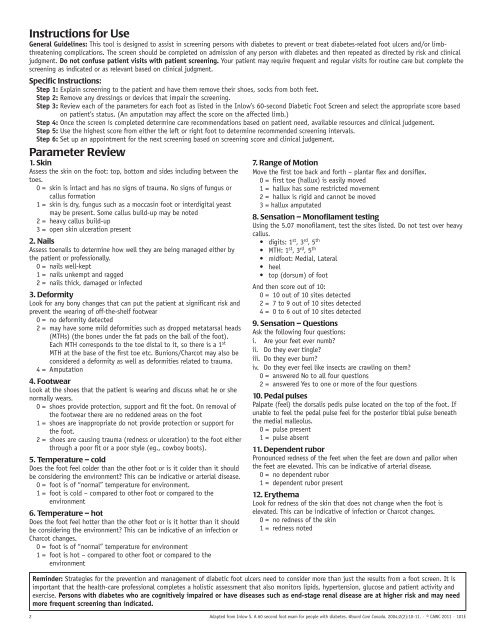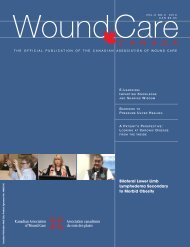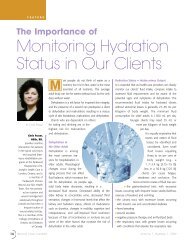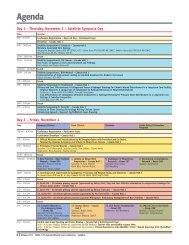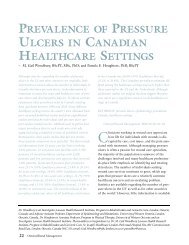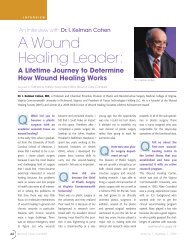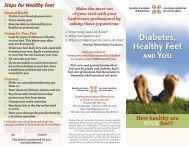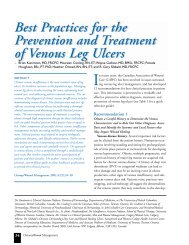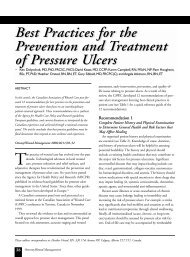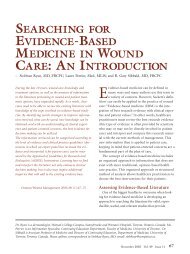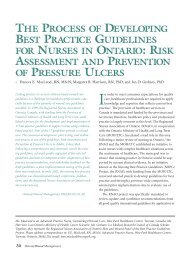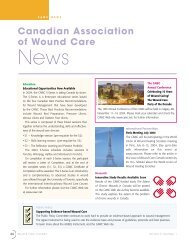Inlow's 60-Second Diabetic Foot Screen Tool
Inlow's 60-Second Diabetic Foot Screen Tool
Inlow's 60-Second Diabetic Foot Screen Tool
Create successful ePaper yourself
Turn your PDF publications into a flip-book with our unique Google optimized e-Paper software.
Instructions for Use<br />
General Guidelines: This tool is designed to assist in screening persons with diabetes to prevent or treat diabetes-related foot ulcers and/or limbthreatening<br />
complications. The screen should be completed on admission of any person with diabetes and then repeated as directed by risk and clinical<br />
judgment. Do not confuse patient visits with patient screening. Your patient may require frequent and regular visits for routine care but complete the<br />
screening as indicated or as relevant based on clinical judgment.<br />
Specific Instructions:<br />
Step 1: Explain screening to the patient and have them remove their shoes, socks from both feet.<br />
Step 2: Remove any dressings or devices that impair the screening.<br />
Step 3: Review each of the parameters for each foot as listed in the Inlow’s <strong>60</strong>-second <strong>Diabetic</strong> <strong>Foot</strong> <strong>Screen</strong> and select the appropriate score based<br />
on patient’s status. (An amputation may affect the score on the affected limb.)<br />
Step 4: Once the screen is completed determine care recommendations based on patient need, available resources and clinical judgement.<br />
Step 5: Use the highest score from either the left or right foot to determine recommended screening intervals.<br />
Step 6: Set up an appointment for the next screening based on screening score and clinical judgement.<br />
Parameter Review<br />
1. Skin<br />
Assess the skin on the foot: top, bottom and sides including between the<br />
toes.<br />
0 = skin is intact and has no signs of trauma. No signs of fungus or<br />
callus formation<br />
1 = skin is dry, fungus such as a moccasin foot or interdigital yeast<br />
may be present. Some callus build-up may be noted<br />
2 = heavy callus build-up<br />
3 = open skin ulceration present<br />
2. Nails<br />
Assess toenails to determine how well they are being managed either by<br />
the patient or professionally.<br />
0 = nails well-kept<br />
1 = nails unkempt and ragged<br />
2 = nails thick, damaged or infected<br />
3. Deformity<br />
Look for any bony changes that can put the patient at significant risk and<br />
prevent the wearing of off-the-shelf footwear<br />
0 = no deformity detected<br />
2 = may have some mild deformities such as dropped metatarsal heads<br />
(MTHs) (the bones under the fat pads on the ball of the foot).<br />
Each MTH corresponds to the toe distal to it, so there is a 1st MTH at the base of the first toe etc. Bunions/Charcot may also be<br />
considered a deformity as well as deformities related to trauma.<br />
4 = Amputation<br />
4. <strong>Foot</strong>wear<br />
Look at the shoes that the patient is wearing and discuss what he or she<br />
normally wears.<br />
0 = shoes provide protection, support and fit the foot. On removal of<br />
the footwear there are no reddened areas on the foot<br />
1 = shoes are inappropriate do not provide protection or support for<br />
the foot.<br />
2 = shoes are causing trauma (redness or ulceration) to the foot either<br />
through a poor fit or a poor style (eg., cowboy boots).<br />
5. Temperature – cold<br />
Does the foot feel colder than the other foot or is it colder than it should<br />
be considering the environment? This can be indicative or arterial disease.<br />
0 = foot is of “normal” temperature for environment.<br />
1 = foot is cold – compared to other foot or compared to the<br />
environment<br />
6. Temperature – hot<br />
Does the foot feel hotter than the other foot or is it hotter than it should<br />
be considering the environment? This can be indicative of an infection or<br />
Charcot changes.<br />
0 = foot is of “normal” temperature for environment<br />
1 = foot is hot – compared to other foot or compared to the<br />
environment<br />
7. Range of Motion<br />
Move the first toe back and forth – plantar flex and dorsiflex.<br />
0 = first toe (hallux) is easily moved<br />
1 = hallux has some restricted movement<br />
2 = hallux is rigid and cannot be moved<br />
3 = hallux amputated<br />
8. Sensation – Monofilament testing<br />
Using the 5.07 monofilament, test the sites listed. Do not test over heavy<br />
callus.<br />
• digits: 1st<br />
, 3rd , 5th • MTH: 1st<br />
, 3rd , 5th • midfoot: Medial, Lateral<br />
• heel<br />
• top (dorsum) of foot<br />
And then score out of 10:<br />
0 = 10 out of 10 sites detected<br />
2 = 7 to 9 out of 10 sites detected<br />
4 = 0 to 6 out of 10 sites detected<br />
9. Sensation – Questions<br />
Ask the following four questions:<br />
i. Are your feet ever numb?<br />
ii. Do they ever tingle?<br />
iii. Do they ever burn?<br />
iv. Do they ever feel like insects are crawling on them?<br />
0 = answered No to all four questions<br />
2 = answered Yes to one or more of the four questions<br />
10. Pedal pulses<br />
Palpate (feel) the dorsalis pedis pulse located on the top of the foot. If<br />
unable to feel the pedal pulse feel for the posterior tibial pulse beneath<br />
the medial malleolus.<br />
0 = pulse present<br />
1 = pulse absent<br />
11. Dependent rubor<br />
Pronounced redness of the feet when the feet are down and pallor when<br />
the feet are elevated. This can be indicative of arterial disease.<br />
0 = no dependent rubor<br />
1 = dependent rubor present<br />
12. Erythema<br />
Look for redness of the skin that does not change when the foot is<br />
elevated. This can be indicative of infection or Charcot changes.<br />
0 = no redness of the skin<br />
1 = redness noted<br />
Reminder: Strategies for the prevention and management of diabetic foot ulcers need to consider more than just the results from a foot screen. It is<br />
important that the health-care professional completes a holistic assessment that also monitors lipids, hypertension, glucose and patient activity and<br />
exercise. Persons with diabetes who are cognitively impaired or have diseases such as end-stage renal disease are at higher risk and may need<br />
more frequent screening than indicated.<br />
2 Adapted from Inlow S. A <strong>60</strong> second foot exam for people with diabetes. Wound Care Canada. 2004;2(2):10-11. · © CAWC 2011 · 101E


